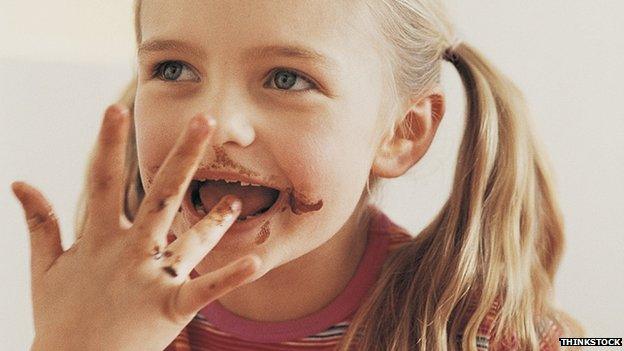Does chocolate give you spots?
- Published

Telling children that they'll get pimples is one way to encourage them go easy on the chocolate - but is it true?
When it comes to Easter eggs, every child has a favourite strategy.
Some stash their hoard, tormenting their siblings for months with their untouched rows of chocolate goodies.
Others descend on their eggs like a fox on a bird's nest, scattering scraps of foil and shards of broken chocolate all over the carpet.
This category of child may well prompt the smug response from nearby grown-ups "You'll get spots!" At which point, another, even smugger, adult may well respond: "Actually, that's a myth!"
But is it a myth? It would be more accurate to say that it is a matter of scientific debate.
Multiple factors contribute to the prevalence of acne - the skin disease characterised by spots or pimples - including family history, age and possibly stress levels.
Until the 1960s, the view that chocolate exacerbated the problem was widely held in the scientific community. It was thought that acne sufferers had an impaired tolerance of glucose, the sugar which our bodies convert carbohydrates into for distribution in the bloodstream. Popular textbooks of the 1940s and 1950s counselled against sugary food and drink - including chocolate - as part of acne treatment.
But a very influential 1969 study by JE Fulton and his colleagues G Plewig and AM Klingman appeared to scotch any association between chocolate and acne.
The researchers took 65 participants with mild-to-moderate acne and divided them into two groups. One group was given a chocolate bar enriched with 10 times the normal amount of cocoa. The other group was given a placebo bar (without the extra cocoa). The groups were told to eat the bars daily for a month.
After a three-week break, the two groups switched bars. The researchers, who examined the patients weekly, decided that chocolate had no effect on acne development.
This study made a big impact, and has been cited dozens of times in other journal articles. But it has recently been roundly criticised.
"This study, to my mind, is invalid," says Amy Brown, associate professor at the University of Hawaii at Manoa, one of seven signatories to a 2011 letter criticising the Fulton study, printed in the journal Clinics in Dermatology.
"The very first problem is that it was made possible through the Chocolate Manufacturers' Association of the United States of America - that's number one," she says.
She also lists a number of methodological problems. For example, she says the weekly examinations could have missed skin reactions that occurred mid-week. And at the end of the study changes in skin condition were only counted if they were 30% better or worse, so a 29% deterioration in a participant's acne would not have been noted.
"It was published in the journal of the American Medical Association and everybody just believed it," says Brown. "People took these researchers' word for it and that was it."
It became scientific orthodoxy that chocolate did not cause or aggravate acne. In 40 years, just one further study looked at the links between the two, and this took in a range of other sweet foods as well.
In 1971 Anderson and his colleagues took 27 university students, divided them into groups and asked them to eat large amounts of chocolate, milk, fizzy drinks and roasted peanuts every day for a week. At the end of the week, no new outbreaks of acne were noted.
The small timescale and sample size of this study - together with the lack of a control group - make it hard to draw firm conclusions.
So in 2011 it seemed to one medical student that the question of chocolate and acne was long overdue a re-examination.
"There's a very small amount of literature that's actually been done assessing the effect of chocolate on acne exacerbation," says Samantha Block of the University of Miami Miller School of Medicine.
As part of pilot study - reported in the Journal of the American Academy of Dermatology - she and her research partners chose 10 male volunteers between the ages of 18 and 35.
The participants chosen all had between one and four non-inflamed spots, to ensure that they were susceptible to acne but not currently suffering from a bad flare-up of the condition. Women were excluded because of the effect that menstruation cycles have on hormone levels, which can affect acne.
Block felt that one weakness of both the Fulton and Anderson studies was that the bars used were not pure chocolate. Since she wasn't interested in the effect of additives like sugar and sweeteners she used 100%-cocoa chocolate.
Another change distinguished it from the Fulton experiment - one particularly relevant to this time of year.
"We wanted to emulate what people typically consider exacerbating their acne - which is a binge chocolate consumption," she says.

A bar this size might contain 100g (3.5oz) of chocolate or more, depending on thickness
She made her participants eat varied amounts of chocolate (up to 340g, or 12oz) on day one of the experiment and then assessed their acne on day four and day seven. She found that acne increased on the participants' faces, in proportion to the amount of chocolate they had eaten.
More recently, Block has repeated the pilot study with a control group and a randomised method, feeding participants with capsules containing either 100% cocoa powder, or gelatine.
Different quantities of the two capsules were assigned randomly to 14 participants in what scientists call a "double blind" experiment - neither the participants nor the researchers knew who had been given what until after the experiment.
The study, which Block has presented at a national conference of the American Academy of Dermatology, again showed an increase in acne proportionate to the amount of chocolate eaten.
"It seems to be that for a male subject between the ages of 18 and 35 with a history of acne, chocolate does seem to exacerbate their acne," Block says.
She hopes that further experiments will test her findings with larger groups of participants, including women. But for now the scientific jury is still out - an article about Block's work is currently under review for publication in a scientific journal - so it is possibly too soon to allow her results to dictate our behaviour this Easter.
So much for pure chocolate. But what about the chocolate most of us eat - that dodgy stuff that does indeed have additives, including sugar, milk, fruit, nuts and other flavourings?
A new review paper, published in the Journal of the Academy of Nutrition and Dietetics, examines all the research done on the links between acne and diet in general, not just chocolate.
Its author, Jennifer Burris, is also critical of the Fulton and Anderson studies, and she expresses bafflement over how their results have been misinterpreted by others.
"Although the main outcome of this old research primarily investigated chocolate and acne, it was falsely interpreted to imply diet was not associated with acne," she says.
She calls it a scientific "myth" which her review paper challenges. Looking at more recent research - not on chocolate, but a range of other foods - she and her fellow researchers conclude that there may be a link between diet and acne, although they don't know how strong it is.
"We're not really sure if diet can cause these acne flares or maybe they just make them more severe," she says.
The researchers are also unsure if the culprits are dairy products or foods that give blood sugar levels a big boost (those with a high "glycemic load"). The role of Omega 3 fatty acids is also unclear.
Burris also doesn't rule out other pathways through which diet might affect your skin.
"Some chocolate bars are high in saturated fat or partially hydrogenated fats - trans fats - which may increase inflammation, possibly contributing to inflammatory acne," she says, adding that this theory has not yet been proved.
Of course, the fact that science has not, to date, shown conclusively that chocolate - pure or impure, in bar-form or egg-shaped - causes acne is unlikely to stop adults using the threat of spots to try and slow down their children's intake.
But be warned - to do this is to open a chocolatey can of worms.
The quick-witted child is sure to respond with a long list of supposed health benefits of eating chocolate, from helping protect the heart, to slimming, to just making us feel good, external.
You can listen to Health Check on the BBC World Service. Listen back to an interview with Jennifer Burris via iplayer or browse the documentary podcast archive.
You can follow the Magazine on Twitter , externaland on Facebook, external.